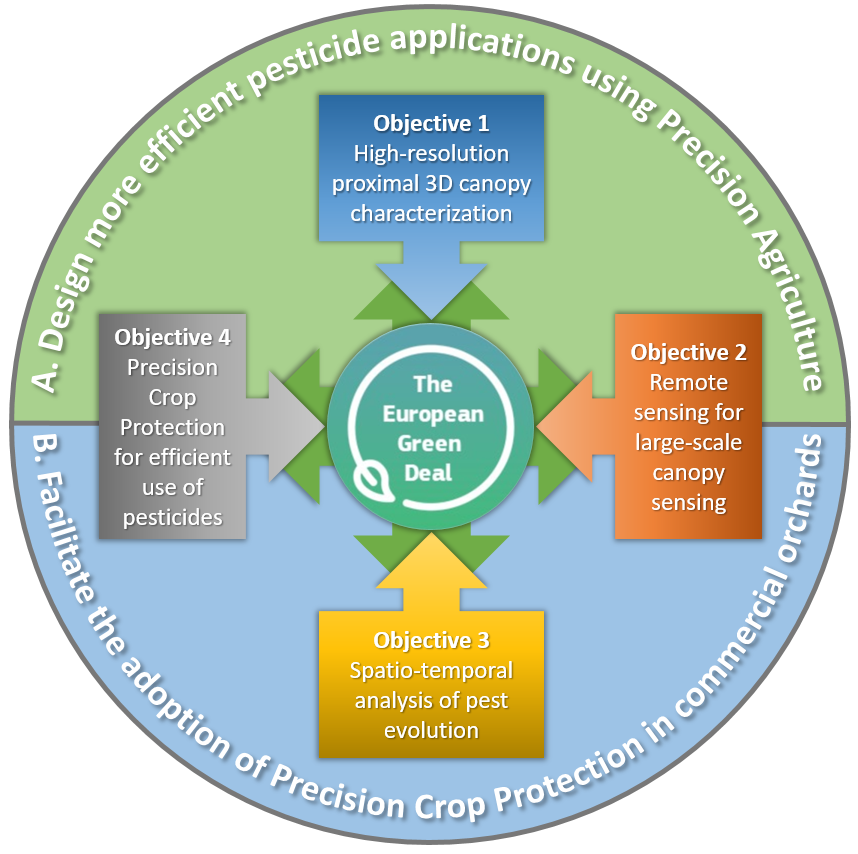PAgPROTECT - Project information
Download PdfThe PAgPRTOECT project is focused on applying Precision Agriculture (PA) techniques and technologies to address key issues stated in the Farm to Fork (F2F) strategy. This strategy is the agricultural core of the European Green Deal, recently proposed by the European Commission aiming at making food systems fair, healthy and sustainable. Specifically, the F2F strategy demands to reduce the risk and use of pesticides to 50 % by 2030, a very ambitious goal that certainly requires research, transfer and innovation to be accomplished. Furthermore, being more efficient using pesticides is linked to being more efficient in the use of agricultural machinery and this is affecting decarbonisation, which is included in the Climate, energy and mobility thematic priority of the Horizon Europe Work Programme 2021-2022; and also fits within the strategic line Smart and sustainable food chain of the Spanish National Plan of Scientific-Technic Research and Innovation 2021-2023. This includes research on Smart Agriculture, on the F2F estrategy, on digital primary production, on sustainable soils and on remote sensors. All those areas are included in the present proposal and will be developed in the work plan focused on woody (apple and almond) crops. These crops are of high importance in Spain and in the Ebro Valley, because of their high economic and social impact, having high demand of pesticides.
In this respect, the main objectives of the project are:
- A. Design more efficient pesticide applications by looking for synergies between Precision Agriculture techniques and technologies which are already proven on its own.
- B. Facilitate the adoption of Precision Crop Protection by scaling the developed solutions up for commercial orchards.
Four actions included in four specific objectives are proposed with the hypothesis that they will lead to improve pesticide use efficiency and reduction:
- Accurate proximal determination of key geometric and structural canopy parameters, such as canopy porosity/leafiness and leaf area index to better adjust pesticide dose rates in a site-specific map-based approach.
- Scaling of that information up with detailed remote sensing satellite images to generalize the use of map-based prescriptions in orchards.
- Spatio-temporal analysis of the evolution of pests at both regional and orchard scale using insect population traps and geostatistics.
- Improvement of the global efficiency of pesticide applications through variable-rate technology optimization.
Several novelties are presented in the present proposal with respect to previous projects carried out by the applicant research group (GRAP):
- Better characterization of canopy porosity from multi-beam LiDAR data.
- Combination of high resolution measuring techniques of canopy parameters with remote sensing to scale them up and use this information to design more efficient pesticide treatments at commercial orchard scales.
- The analysis of the spatial and temporal distribution of pests at both regional and plot scales will lead to more effective and efficient pesticide applications.
- Finally, the data collected from agricultural machinery about its working parameters will allow the analysis of energy efficiency of the operations for optimization possibilities and for traceability of the pesticide applications.
PROJECT DATA
Reference: PID2021-126648OB-I0
Call: Proyectos de Generación de Conocimiento 2021
Mode: Investigación Orientada Tipo B
Funding organizations: MINISTERIO DE CIENCIA E INNOVACIÓN, AGÈNCIA ESTATAL DE INVESTIGACIÓN I ERDF (FEDER)
Total awarded: 242.000 €
Direct costs: 200.000 €
